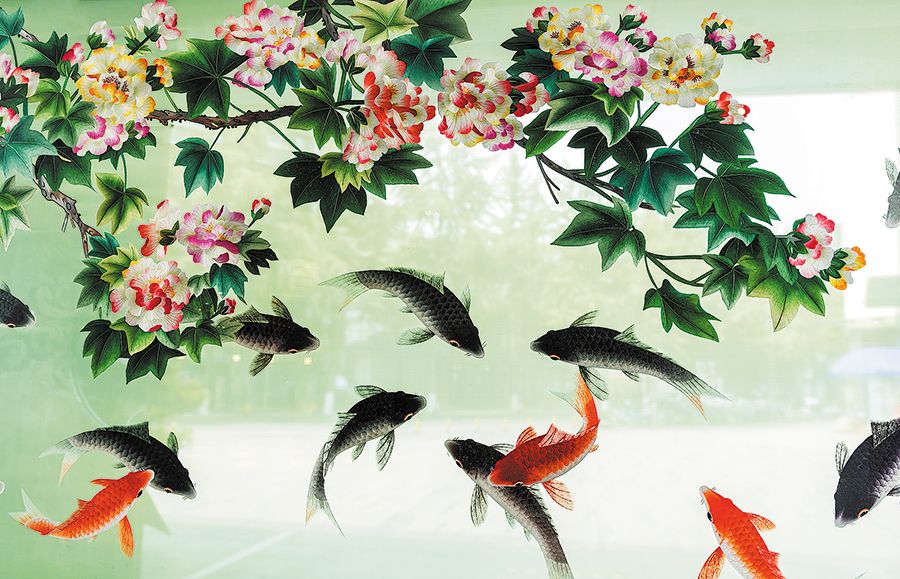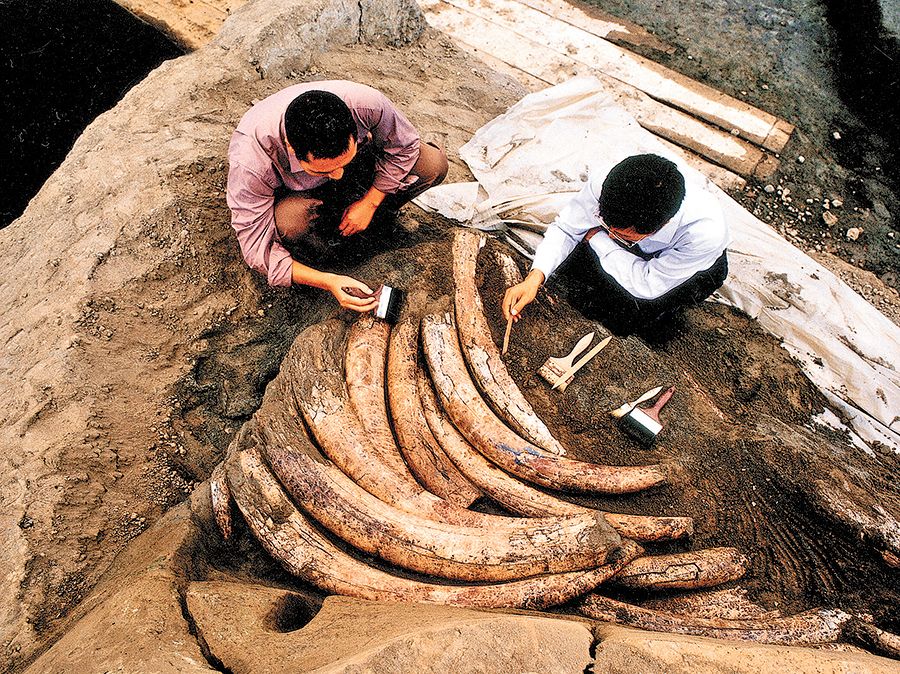
▲The Dujiangyan Irrigation System still functions more than 2,000 years later. (Photo: China Daily)
History of craftsmanship, industrial ingenuity and scholarly ideals among what Chengdu has given to Chinese culture
The Sanxingdui Ruins site in Guanghan, Southwest China's Sichuan province, unveiled its new discovery of six "sacrificial pits" in March 2021.
More than 10,000 artifacts have been unearthed from the pits, which date back more than 3,000 years, including gold masks, bronzewares, ivories, jades and textiles.
These cultural relics offer new clues to the civilization of the ancient Shu state, which dominated today's Sichuan province thousands of years ago, according to archaeologists.
Surprisingly, the newly-discovered golden masks are similar in shape to the golden mask unearthed at the Jinsha site in Chengdu, Sichuan province, indicating a cultural continuity between the two sites.
The city of Chengdu has an urban history of more than 2,300 years while its civilization spans more than 4,500 years.
The Jinsha site is considered the second political, economic and cultural center of the ancient Shu state, after the Sanxingdui Ruins site.
Among cultural relics housed in the city's Jinsha Site Museum is a gold foil ornament featuring the sun and immortal birds, which was declared a symbol of Chinese cultural heritage in 2005.
The gold ornament measures only 0.2 millimeters in thickness and includes a combination of two sacred images. In the middle is a sun with 12 rays, and around the sun, four immortal birds fly counterclockwise.
It has a well-designed composition with fluid lines, demonstrating the ancient Shu people's exquisite craftsmanship and their pursuit of unity, tolerance and harmony.
In addition to the Jinsha site, Chengdu is home to a throng of cultural sites embodying its profound civilization such as the Wuhou Shrine Museum and the Du Fu Thatched Cottage Museum.
There are also rich intangible cultural heritages that have been passed down for thousands of years such as Sichuan Opera along with Shu brocade and embroidery.

▲A classic work of Sichuan embroidery. (Photo: China Daily)
The cradle of civilization
The Chengdu Plain has fertile soil and a wet climate, making it an ideal place for planting mulberry trees and sericulture.
Can Cong, the first king of the Shu state, is traditionally believed to be a silkworm-breeding expert.
During the period before the Qin Dynasty (221-206 BC), silk had become one of the important products for international trade. A trade route linking Chengdu with South and Central Asia had been built, which is known as the "Southern Silk Road" today.
Shu embroidery and brocade gained huge popularity during the Qin Dynasty to the Three Kingdoms (220-280). Chengdu therefore became one of the three major centers for silk production and trade in China.
To manage and regulate the local brocade industry, the Shu Kingdom, one of the three regimes during the Three Kingdoms, set up a special office in Chengdu.
The officials were named jinguan, literally people who take charge of brocade, while the office was named jinguancheng. As a result, later generations referred to Chengdu as Jincheng or Jinguancheng.

▲A performance of Sichuan Opera face changing. (Photo: China Daily)
Land of abundance
The Chengdu Plain was hit hard by floods and droughts during the ancient Shu state period.
It was not until the Warring States Period (475-221 BC), when Li Bing, governor of the Shu prefecture (roughly today's Chengdu), initiated the Dujiangyan Irrigation System. It transformed the plain into a "land of abundance" and benefited millions of people.
Thanks to its favorable natural conditions, rich resources and thriving brocade industry, Chengdu experienced rapid growth during the Qin and Han dynasties (221 BC-AD 220), becoming one of the five major cities at that time.
During the Three Kingdoms, Chengdu was the capital of the Shu Kingdom. During the Tang to Song dynasties (618-1279), the city built itself into a metropolis and made remarkable achievements culturally and economically.
Today, Chengdu is famous for its relaxed lifestyle and optimistic residents. Such a cheerful character has been passed from one generation to the next for thousands of years.
Since the mid-1950s, numerous figurines of comedians from the Han dynasties (206 BC-AD 220) have been unearthed in Chengdu. All of these terracotta figurines have a radiant and smiling face. Even after 2,000 years, people can see how happy and satisfied they were at that time.

▲Ivory unearthed at the Jinsha site. (Photo: China Daily)
Flagship public school
In Chengdu, Shishi High School is the ideal school of many local students.
But what people may not know is that the school's predecessor is China's first public school: the Stone Chamber of Wen Weng.
Wen Weng was the governor of Shu prefecture during the Western Han Dynasty (206 BC-AD 24). He emphasized education and built the school in 141 BC to cultivate talent.
According to historical records, the school selected students from the public including those in poverty-stricken regions.
At school, Wen was committed to improving the students' literacy skills and ability to handle official business, while imparting Confucianism to them.
Wen received wide recognition for his efforts and policies. In 124 BC, Emperor Wu (156-87 BC) in the Western Han Dynasty ordered authorities across the country to set up public schools like the Stone Chamber of Wen Weng.

▲A piece of lacquerware showcased at Chengdu Museum. (Photo: China Daily)
First paper currency
Paper money was first invented in Chengdu during the Song Dynasty (960-1279).
At that time, the common currency in Sichuan was tieqian (iron coins), which were too heavy to transport.
As Chengdu's economy boomed and trade increased, local merchants needed a more convenient way to carry large sums of money.
As a result, they invented jiaozi which was basically pieces of paper used as a certificate of deposit.
Traders were issued jiaozi after depositing strings of coins in a jiaozi shop. When they needed money to buy goods in different places, they could withdraw coins by presenting jiaozi to any accredited shop.
Jiaozi became increasingly popular among merchants, so that it began to serve as money itself.
In 1023, the government took over the production of jiaozi and founded a jiaozi office in Chengdu, which issued the first batch of official banknotes one year later. The office was hence regarded by scholars as the world's first central bank.

▲Photo: China Daily
Immigration to Sichuan
Chengdu has witnessed several waves of immigration throughout history. The eighth immigration happened during the Ming and Qing dynasties (1368-1911) when wars and famine were taking place and Chengdu's population declined dramatically.
In 1694, Emperor Kang Xi (1654-1722) of the Qing Dynasty rolled out a slew of incentives, encouraging residents from some 10 provinces including Hubei, Hunan, Jiangxi, Anhui and Guangdong to immigrate to Sichuan.
The mass immigration lasted for more than 100 years, with millions of people relocating. During this period, local culture integrated with cultures of different regions and thrived.
Sichuan Opera, for example, was formed during that time, which integrates various dramas brought by immigrants with local dialects, folk music and dances.
Sichuan Opera features humorous dialogues, lively music, and a system of stylized movements. Audiences agree that its performance is impressive and stunning.
Sichuan food, meanwhile, absorbed various dietary styles brought by immigrants, becoming a special cuisine combining both southern and northern flavors. (End)
By/Yuan Shenggao

